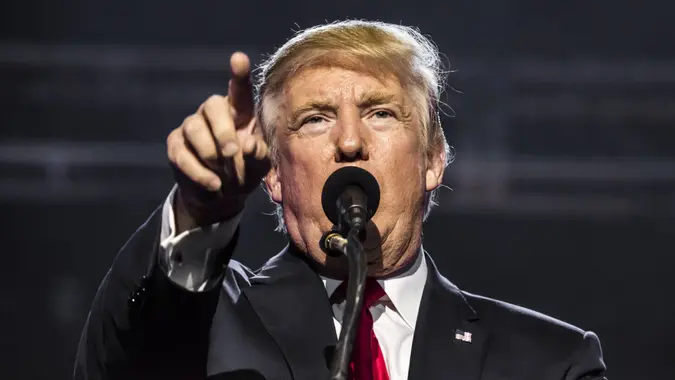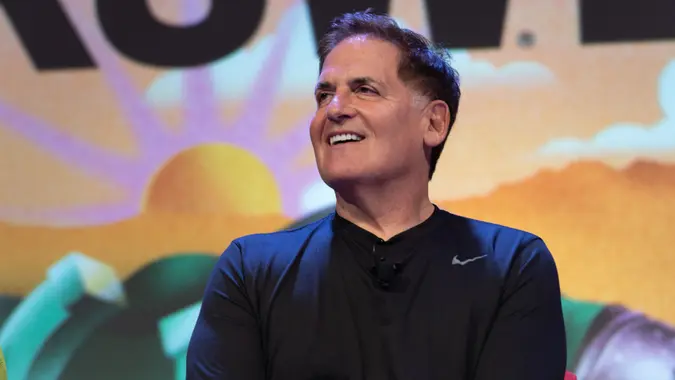How Much Does the President Control Gas Prices?

Commitment to Our Readers
GOBankingRates' editorial team is committed to bringing you unbiased reviews and information. We use data-driven methodologies to evaluate financial products and services - our reviews and ratings are not influenced by advertisers. You can read more about our editorial guidelines and our products and services review methodology.

20 Years
Helping You Live Richer

Reviewed
by Experts

Trusted by
Millions of Readers
Although gas prices, especially where they sit now, are often assumed to be a force of political influence, they are actually governed by economic drivers and basic laws of supply and demand. Unfortunately, President Biden can’t just push a button and let everyone pay $3 per gallon again.
The current oil price crisis escalated in dramatic layers over the course of the past two years. OPEC+ oil-producing countries decided to halt production of oil during the pandemic in response to a sharp decrease in demand, specifically airline and commercial travel. In April 2020, these member countries were actually sitting on a surplus of oil (greater supply than demand), and with the pandemic developing rapidly in its early stages they decided to cut back production to protect their supply and sustain prices as much as they could.
Then in July 2021, these countries reached an agreement to begin pumping more oil in an attempt to reach pre-COVID levels after cutting back due to supply chain blockages during the pandemic.
One of the greatest stressors for oil prices during the recovery was the unprecedented timelines in which demand then quickly shot back up — but without the readiness of oil-producing countries to suddenly shoot supply back up.
This first force, a high demand and constricted supply, was the first price gauge to oil prices. In October 2021, the OPEC countries decided to not increase output despite increasing demand sending West Texas Intermediate crude up 3% to $78.13. Brent crude also shot up past 3% to $81.77 a barrel at the time.
Any U.S. president would have little to do with this, as the OPEC countries operate independently based on their own production incentives, much to the chagrin of Western leaders.
As of this morning though, West Texas Crude — the U.S. benchmark — now sits at a whopping $121.72, with Brent crude — the international benchmark — at $125.69. So are the same forces to blame?
Much has changed since October, but supply and demand are still driving the unrelenting price surges in oil. With Russia in its 13th day of war on Ukraine, oil markets have been in full panic mode for the past month or so, but not because of any significant threat to the United States.
Russia produced 10 million barrels of oil a day — an amount The New York Times says is roughly one out of every 10 barrels used around the world on any given day. The USA, though, would not be directly affected in any significant way if there was to be a ban on Russian oil imports, as Russia exports only about 700,000 barrels a day to the U.S., the NYT adds. To put this into perspective, the U.S. consumes about 18 million barrels of oil per day. This relatively small amount of oil, for America, can be attained elsewhere.
The United States also has a spare supply underneath the ocean in salt caverns in the Gulf of Mexico — the rest of the world does not.
Interruption of pipelines in northern Europe and the Ukraine could distort much of the oil supply chain in Europe and cripple global oil markets, which could — and most likely would — trickle back down to the U.S. This would ultimately be, traders say, because the rest of the world does not have the spare capacity to replace Russian oil. This perfect storm of pandemic stressors now sandwiched on top of international conflict has compounded the oil problem.
So while the president has the mechanism of oil reserves at his disposal in the United States, they ultimately do little to control oil prices, as evidenced over the past few months. Biden announced back in November he would release oil from the country’s reserves, but surging global inflation and supply chain issues held back any hopes of reprieve at the gas pump.
Now, with geopolitical tensions and uncertainty at an all-time high, U.S. consumers will likely need to weather several more months of high prices at the pump. Overall though, U.S. consumers should also consider themselves lucky as they are in a far better position than their more-exposed neighbors across the pond. For Americans, it will hopefully be more of a long nuisance than anything else, relatively speaking.
More From GOBankingRates
 Written by
Written by  Edited by
Edited by 

























